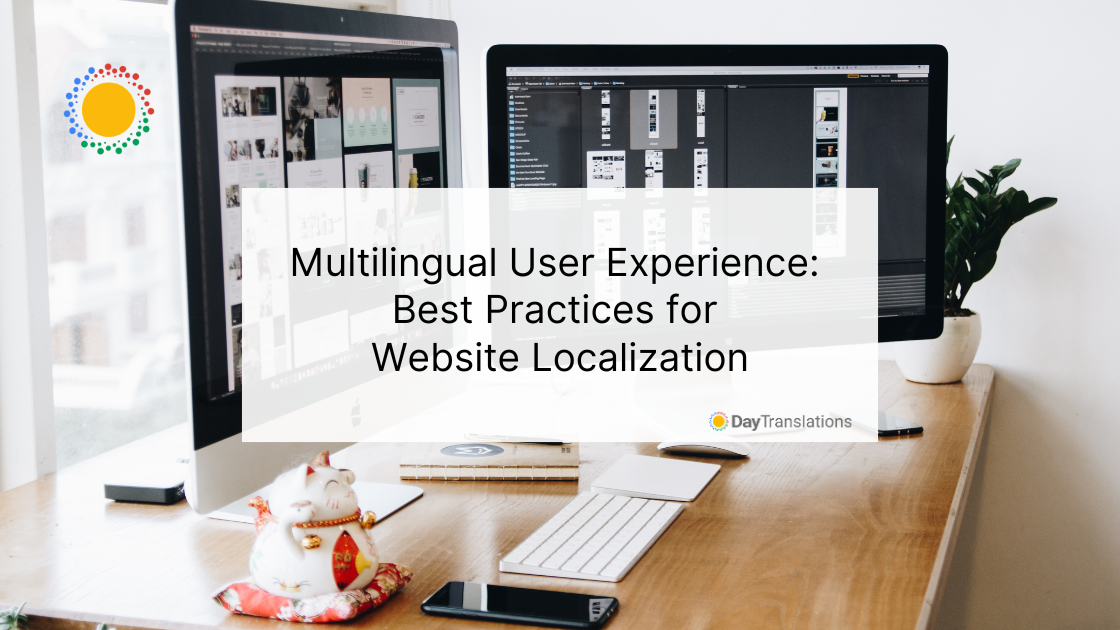In a world where information transcends borders, websites need to speak multiple languages. But simply translating the words on the page isn’t enough. The true challenge is delivering the perfect multilingual user experience (UX) in any language.
This blog post cuts through the confusion and provides website localization best practices that prioritize UX.
How to Determine if Your Website Needs a Multilingual Feature?
Conducting a thorough target audience analysis is a crucial precursor to determining the necessity of incorporating a multilingual feature into your website.
Take StudioSuits, known for its fine custom men’s tweed suits. Despite a global reach, their focus caters to English speakers from the United States and the United Kingdom.
Prioritizing its core audience, StudioSuits streamlines navigation and communication for an optimal user experience.
This deliberate choice to not add multilingual support highlights the importance of tailoring website features to the preferred language of the core user base, enhancing accessibility and engagement.
Website Localization Best Practices for Success
Want to localize your website successfully? Here are some best practices to follow to benefit from your localization efforts.
1. Understand your Audience
Before you begin, thoroughly understand your potential customers:
- Cultural preferences
- Native language
- Online behavior
Take some time to research popular phrases, humor, and local expectations for design and layout. From there, tailor your content to their specific needs and avoid cultural mistakes.
Spending the extra time and effort learning about your audience builds trust and resonates well with overseas customers.
Not sure where to find this information? Take a peek at Google Analytics or your customer relationship management (CRM) platform. You’ll unlock a treasure trove of information about your website visitors.
For instance, Google Analytics shares detailed breakdowns of users by country over time. With that information in hand, you can learn more about your audience’s preferred languages.
2. Search Engine Optimization (SEO)
Search engines prioritize content relevant to the user’s location and language.
So, study local search trends and optimize your content for each language. For best results, use in-language keyword tools to adjust your meta descriptions for relevance.
For off-page SEO, invest in building backlinks from local websites and consider a localized domain name for maximum visibility.
Pro tip: Nearly 70% of digital marketing experts believe backlinks greatly impact search engine rankings. So don’t skimp out on building high-authority backlinks through creating valuable content and participating in guest posting on other blogs.
3. Offer Local Payment Methods
Show your commitment to customers by offering local payment methods they already know and trust.
Alongside credit cards and PayPal, consider integrating popular regional wallets (e.g., M-Pesa in Kenya, Alipay in China), cash on delivery, and bank transfers.
Why do this? When you add multiple payment methods to your website, it reduces checkout abandonment and increases sales.
4. Provide Local Customer Support
Provide 24/7 customer support in the languages your audience speaks. Train your support team on local nuances and cultural sensitivities.
Take, for instance, the innovative brand Hims, renowned for its diverse range of health and wellness products. A closer examination of their website reveals a judicious application of multilingual support features.
While their product page addressing hair loss remains streamlined with a singular language option, the support page adopts a more inclusive approach, offering diverse language variations.
For convenient support, they offer multiple contact channels like live chat, email, phone, and self-service.
Pro-tip: Responsive, personalized support that caters to cultural expectations strengthens customer loyalty and drives repeat business.
5. Social Media Integration
Integrate your multilingual websites with relevant social media platforms in each target market.
Share localized content, engage with audiences in their language and run targeted campaigns. This helps build strong communities around your brand in each language.
6. Focus on Mobile Optimization
Most website traffic comes from smartphones, so your localized versions must deliver a seamless user experience on all devices.
Optimize layouts, content formats, and navigation for smaller screens. Mobile users are more likely to convert when they have a smooth and efficient experience.
7. Localization-Friendly Content Management System
Select a content management system (CMS) that simplifies localization processes.
Look for features that directly support localization, such as:
- Robust version control for tracking content changes across languages
- Built-in language-switching mechanisms
- Dedicated translation workflows
A localization-friendly CMS offers several key benefits:
- Enhanced consistency across different language versions
- Minimized technical effort and improved maintenance
- Ease of expansion in your global web presence
- Time savings in managing multilingual content
- Streamlined content updates for all languages
8. Seamless and Secure Authorization
Multilingual websites face the challenge of secure user authentication across languages and regions. OAuth, an open authorization standard, provides a seamless solution.
Users log in with existing accounts (Google, Facebook, etc.) and grant the website access to their data, removing the need for multiple accounts and passwords. This guarantees a consistent and convenient customer experience regardless of language or location.
8 Simple Steps for Website Localization
Now that you’ve learned the website localization best practices, it’s time to put them into action. Start your localization process with this checklist:
1. Define your Target Audience
- Research your target market’s demographics, culture, language, and online behavior.
- Understand their needs, preferences, and pain points.
2. Develop a Localization Strategy
- Decide on the level of localization (full website, specific pages, etc.).
- Define your key performance indicators (KPIs) for success.
- Choose the languages you want to target.
- Set a budget and timeline.
3. Build your Localization Team
- Assemble a team with expertise in translation or freelance translators, localization, project management, and web development.
- Consider hiring native speakers of your target languages.
4. Prepare your Website for Localization
- Design your website with localization in mind (e.g., avoid hardcoded text in images).
- Ensure your website’s code is flexible and adaptable to different languages.
- Use UTF-8 encoding to support multiple character sets.
5. Translate your Content
- Use a translation management system for efficiency and consistency.
- Avoid literal translations — focus on cultural adaptation and nuance.
- Use professional translators with experience in localization.
6. Adapt your Design and Layout
- Adjust fonts, colors, images, and symbols to resonate with your target audience.
- Ensure proper formatting and date/time displays for different regions.
- Consider cultural differences in visual preferences and layout.
7. Test and Refine
- Thoroughly test your localized website for functionality and cultural appropriateness.
- Make adjustments based on feedback and data.
- Conduct user testing with native speakers.
8. Launch and Promote your Localized Website
- Monitor performance and continuously improve your localization efforts.
- Develop a marketing strategy to reach your target audience.
- Optimize your website for local search engines (SEO).
Improve Your Reach With Website Localization Best Practices
Ready to unlock a world of possibilities? Localize your website and watch your brand take center stage across the globe.
Imagine captivating audiences, your website becoming a global hub, and your business soaring to new heights.
Our professional translation services and human interpreting solutions are your passport to global success. We’ll tailor your message to resonate in any corner of the world, ensuring cultural nuances are beautifully preserved.
About the author: Jugraj Singh
Jugraj is a freelance content and copywriter from Delhi, India who’s great at writing compelling content that converts. When not writing, you can find him reading thoughtful books and engaging in socio-cultural discussions, which fuels his creativity.












Sorry, the comment form is closed at this time.